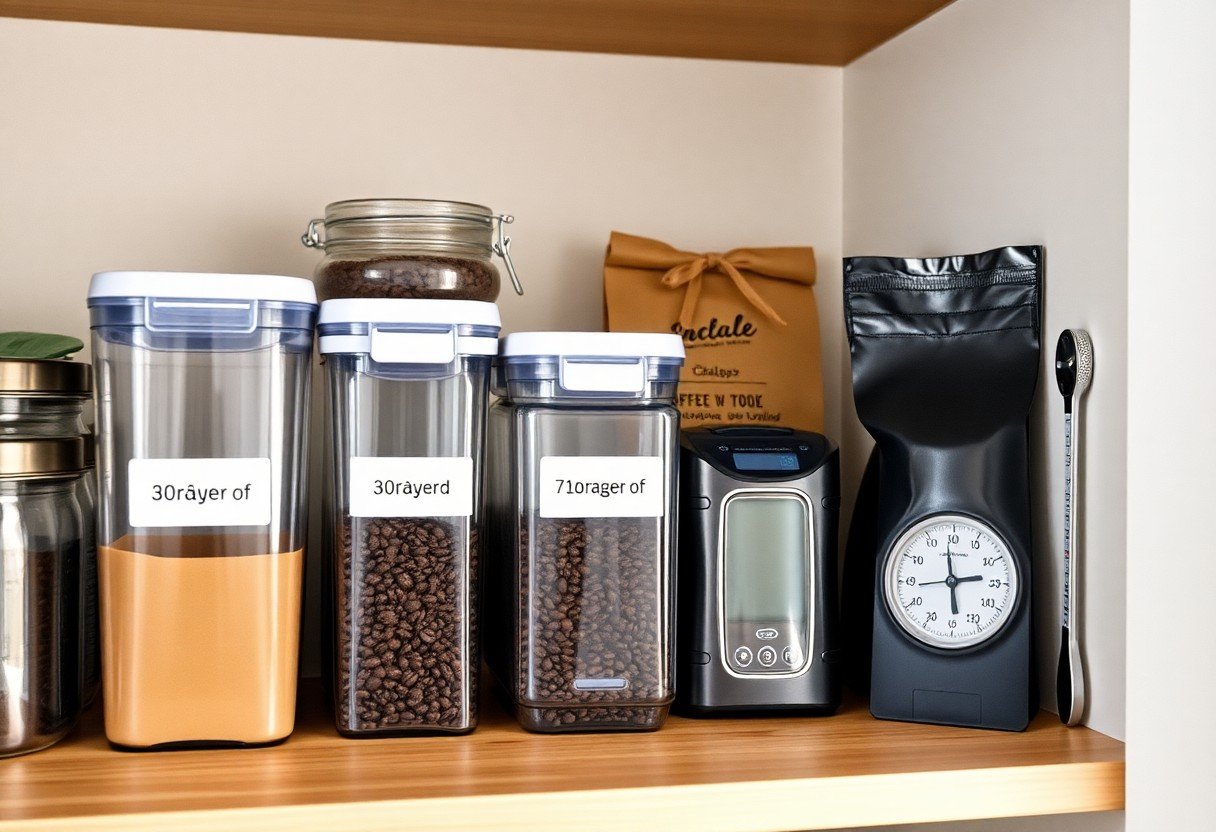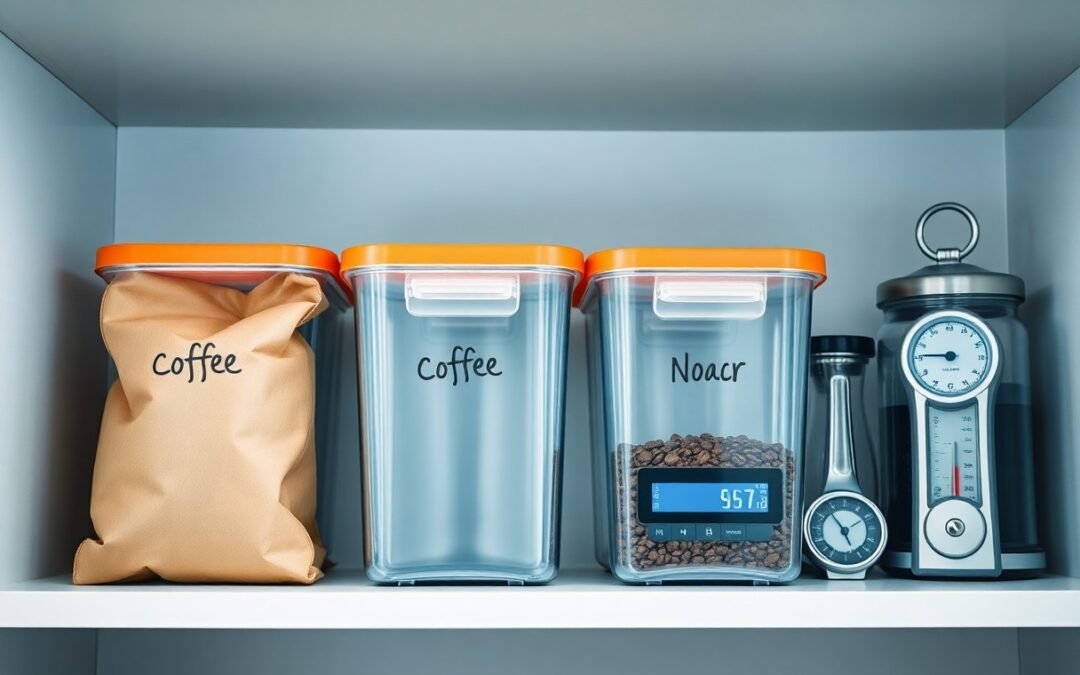Just understanding how to preserve coffee bean freshness can elevate your brewing experience significantly. In this post, you’ll learn everything you need to know about the shelf life of your beloved coffee beans and the best storage practices to keep them at their peak. With proper techniques, you can ensure that every cup you brew is rich, aromatic, and bursting with flavor, enhancing not just your mornings but every coffee moment throughout the day.
The Chemistry of Coffee Beans and Freshness
The intricate chemistry of coffee beans plays a pivotal role in determining their freshness and subsequent quality. Composed of various organic compounds, including lipids, proteins, carbohydrates, and acids, each element contributes to the overall flavor profile and aromatic qualities of your brew. Factors such as roasting time, temperature, and bean type affect these compounds, influencing how they change over time. Understanding this chemistry helps you appreciate the nuances in your cup and guides you in choosing the best beans for optimal freshness.
Essential Elements in Coffee Bean Composition
Your cup of coffee relies on a delicate balance of imperative elements found in coffee beans. The primary components include carbohydrates, which provide energy; proteins, which affect body and mouthfeel; and lipids, responsible for flavor and aroma retention. Additionally, organic acids contribute brightness and complexity to the taste. Each of these elements can be significantly altered by the roasting process and how you store your beans, ultimately affecting your coffee experience.
How Freshness Affects Flavor and Aroma
Shelf Life: The Clock is Ticking
Shelf life plays a vital role in your coffee experience, as even the freshest beans lose their flavor and aroma over time. Typically, roasted coffee beans maintain optimal freshness for about two to four weeks after roasting. Beyond this window, you may notice a dulling of flavors, which can lead to a less enjoyable brew. The key is to consume your beans promptly and store them correctly, allowing you to savor every note of your favorite blend before time runs out.
From Farm to Cup: The Journey of Coffee Beans
Your coffee beans launch on a remarkable journey from farm to cup, passing through various stages that influence their freshness and quality. Harvesting takes place once the cherries are ripe, followed by processing and drying to prepare the beans for export. After they reach roasters, the beans are often roasted in small batches to achieve optimal flavor. Each step of this journey impacts how long those beans will stay fresh, and understanding this timeline is necessary for maximizing your brewing experience.
Understanding the Best Before Date vs. the Use-By Date
Deciphering coffee packaging can be overwhelming, especially when differentiating between the “best before” date and the “use-by” date. The “best before” date indicates when the beans will likely reach their peak flavor, while the “use-by” date signifies the point after which consumption is not recommended, often due to safety concerns. While the best before date suggests a window for optimal taste, your beans may still be usable beyond this, albeit with reduced quality.
The distinction between “best before” and “use-by” dates is particularly significant in the coffee world. While the “best before” date serves as a guideline for when your coffee will be at its best flavor profile, it doesn’t mean the coffee is unsafe to drink afterward. However, the “use-by” date is more strict; it indicates the maximum time frame for quality assurance. For instance, if you have a bag of beans with a “best before” date of two months ago, they may still brew a decent cup, but beans past their “use-by” date should be discarded to avoid health risks. Exploring these dates alongside proper storage practices can help you enjoy your coffee at its finest.

Storage Strategies That Maximize Freshness
Proper storage is vital for maintaining the quality and flavor of your coffee beans. By employing effective strategies, you can significantly extend their shelf life and preserve the rich aromas that make each cup enjoyable. Focus on container choice and environmental conditions to ensure you always have the freshest coffee available at home.
Optimal Containers: Material Matters
Your choice of container makes a difference in how well your coffee beans are preserved. Airtight, opaque containers like glass or ceramic are ideal, as they prevent light exposure and limit air contact. Avoid plastic containers, as they can absorb odors and create static that affects flavor. Investing in a good quality container will pay off in the long-run by keeping your beans fresher for longer.
Ideal Conditions: Temperature, Humidity, and Light
Temperature, humidity, and light play vital roles in maintaining coffee freshness. Store your beans in a cool, dry environment away from direct sunlight. Ideally, the temperature should be between 60°F to 75°F (15°C to 24°C) with low humidity levels. High humidity can lead to mold growth, while excessive heat can cause the beans to lose their flavor compounds. Following these guidelines will help preserve the integrity of your coffee.
Ideal Conditions for Fresh Coffee Beans
| Factor | Recommendation |
|---|---|
| Temperature | 60°F to 75°F (15°C to 24°C) |
| Humidity | Below 60% |
| Light | Avoid direct sunlight |
Keeping coffee beans in ideal conditions ensures that they retain their rich flavors and aromas longer. Temperatures above 75°F accelerate the degradation of flavor compounds, while humidity levels exceeding 60% can encourage mold growth, wreaking havoc on your coffee quality. Store your beans away from ovens, fridges, and direct sunlight to create a stable environment that keeps your coffee vibrant and flavorful.
Environment Considerations for Coffee Freshness
| Environmental Element | Impact on Freshness |
|---|---|
| Heat | Accelerates flavor loss |
| Moisture | Promotes spoilage and mold growth |
| Light | Degrades beans quickly |
Signs Your Coffee Beans Have Gone Past Their Prime
Recognizing when your coffee beans have lost their optimal freshness is vital for brewing the perfect cup. Signs include dullness in color, a lack of aroma, and a flat, stale taste. If you notice a significant decrease in the vigor of your morning brew, it may be time to assess the condition of your beans. Understanding these indicators helps you maintain the quality of your coffee experience, ensuring every sip is as delightful as intended.
Visual and Sensory Cues to Look For
Dull, faded beans and an absence of their usual sheen indicate a potential decline in freshness. Pay attention to the aroma; fresh beans should emit a vibrant, inviting scent. If your coffee smells musty or lacks a distinct fragrance, it’s a sign of staleness. When brewed, if the coffee lacks complexity or seems flat, it reflects the degradation of the beans’ flavors.
The Impact of Old Beans on Your Brew
Old coffee beans drastically alter your brewing outcome. Stale beans contain diminished oils and flavors, leading to a dull, lifeless cup. For instance, using beans that are more than three weeks past their roast date can result in a brew that’s lacking brightness and depth. This not only disappoints your taste buds but also wastes the effort of your brewing process, as even the finest brewing techniques can’t compensate for inferior ingredients.
Beyond Basic Storage: Advanced Techniques and Tips
Taking your coffee storage to the next level involves utilizing more advanced techniques to ensure maximum freshness and flavor. Alongside conventional storage methods, consider employing some innovative strategies.
- Use airtight containers.
- Opt for ceramic or glass over plastic.
- Keep coffee away from direct sunlight.
- Store in a cool, dark place, ideally at consistent temperatures.
- Experiment with nitrogen-flushing for longer-lasting results.
- Avoid placing coffee near strong-smelling items.
- Label your containers with purchase or roast dates.
- Do not blend different roasts in one container.
- Regularly assess your storage area for humidity levels.
- Consider frequency of use; adjust storage methods accordingly.
Vacuum-Sealing and Freezing: The Pros and Cons
Vacuum-sealing and freezing can effectively extend the shelf life of your coffee beans but come with certain drawbacks as well. When done properly, vacuum-sealing locks out moisture and air, crucial for preserving flavor. However, frequent opening of the vacuum bag may expose the beans to air, which negatively impacts freshness.
| Pros | Cons |
|---|---|
| Extends shelf life significantly | Requires specialized equipment |
| Locks out moisture and air | Beans may absorb odors from the freezer |
| Easy to portion control | Changes in texture upon thawing |
| Preserves original flavor profiles | Not ideal for daily usage unless carefully managed |
| Reduces risk of oxidation | Unsealing for use can invite contamination |
Short-Term vs. Long-Term Storage Solutions
Deciding between short-term and long-term storage solutions hinges on how quickly you consume coffee. Short-term storage focuses on retaining flavor for immediate use, while long-term strategies are designed for preserving beans over extended periods without sacrifice in quality. Whether you’re brewing daily or stockpiling blends for future use, understanding each method will help you tailor your storage precisely to your habits.
For short-term storage, an airtight container on your counter or in a cupboard will suffice, allowing easy access while keeping beans in optimal condition for a few weeks. If you tend to buy coffee in bulk or enjoy rare roasts infrequently, long-term solutions like vacuum-sealing or using nitrogen-flushed pouches become more important. Such methods prevent oxidation and moisture damage, ensuring that even those cherished coffee treasures remain fresh for months or even years. Overall, tailoring your approach to your specific coffee consumption patterns can greatly enhance your brewing experience.
Final Words
With this in mind, mastering the freshness of your coffee beans can significantly enhance your brewing experience. By understanding shelf life and proper storage techniques, you can ensure that your coffee retains its rich flavor and aroma. Choose the right containers, store your beans in optimal conditions, and always consider their roast date. By paying attention to these details, you can enjoy a consistently delightful cup of coffee, transforming your daily ritual into an extraordinary experience.
FAQ
Q: What is the ideal shelf life of coffee beans, and how can I maximize their freshness?
A: The optimal shelf life of roasted coffee beans is typically 2 to 4 weeks after the roast date when stored properly. To maximize freshness, keep your coffee beans in an airtight container away from light, heat, and moisture. Additionally, consider buying whole beans and grinding them just before brewing, as ground coffee loses its freshness more quickly. Vacuum-sealed bags or containers designed for coffee storage can also help extend shelf life.
Q: What are the best storage conditions for coffee beans?
A: Coffee beans should be stored in a cool, dark place to prevent exposure to light and heat, which can degrade their quality over time. Avoid storing coffee in the fridge or freezer, as moisture and odors can seep into the beans. Instead, use an opaque, airtight container and keep it in a pantry or cupboard away from appliances that generate heat, such as ovens or toasters. Consistent temperature is key, so choose a location that doesn’t fluctuate significantly.
Q: How can I tell if my coffee beans have gone stale?
A: Stale coffee beans may lose their rich aroma and exhibit a dull, lifeless scent. When brewed, stale coffee often lacks flavor and can taste flat or sour. If the beans feel oily or look significantly faded, they may have lost freshness. A good practice is to observe the roast date on the packaging and try to use the beans within the recommended time frame. If in doubt, trust your senses — if the smell or taste isn’t appealing, it’s time to toss them out.

